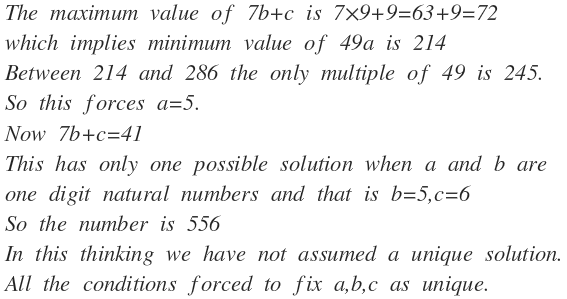JEE Novice - (13)
4 9 a + 7 b + c = 2 8 6
Consider a three digit number a b c whose digits a , b , c satisfy the above equation.Then find a b c .
Note : a , b , c need not be distinct.
This question is a part of JEE Novices .
The answer is 556.
This section requires Javascript.
You are seeing this because something didn't load right. We suggest you, (a) try
refreshing the page, (b) enabling javascript if it is disabled on your browser and,
finally, (c)
loading the
non-javascript version of this page
. We're sorry about the hassle.
2 solutions
Moderator note:
The solution assumes that the answer is unique, instead of showing that it indeed must be unique. For example, if we had 4 9 a + 7 b + c = 1 0 5 , then this approach will yield 2 1 0 , whereas 1 8 0 is also a valid solution.
How is this "extra solution" introduced? And how can we fix it?
I don't really know but the way I got the answer was first trying to reduce 286 to a number so that I'd be divisible by seven (finding c ) and then doing the same thing for 7 2 8 6 − c to find a and b ,Is this also valid?
Extra solution exists when a ≤ 2 and b ≤ 1 , because 4 9 × 1 = 7 × 7 , when we decrease a by 1 , we can add back by increasing b by 7 . Similarly, when b = 1 and c ≤ 2 , we can use b = 0 and c + 7 . For the above case of 4 9 a + 7 b + c = 1 0 5 , 2 0 7 is another extra solution.
[Response to Challenge Master Note]
There's a unique solution ( a , b , c ) to the equation 4 9 a + 7 b + c = x where x is a non-negative integer ≤ 3 4 2 if we put the restriction that a , b , c are non-negative integers less than 7 .
The reason for this is very obvious once we realize that the LHS is actually the base 7 expansion of x when a , b , c are non-negative integers less than 7 . So, in general, with that restriction imposed on a , b , c , the equation is:
a b c 7 = x
For the problem here, we have x = 2 8 6 . We can get the unique solution by the general method for getting the base 7 value which is dividing x by 7 and collecting the remainders (continuing till we get a value less than 7 ). Then, concatenate the remainders (including the last obtained value) going bottom to top.
The "extra solution" 1 8 0 in the shown case is introduced of this:
2 1 0 7 = 2 × 4 9 + 7 × 1 + 0 = 1 × 4 9 + 7 × 7 4 9 + 1 × 7 + 0 = 1 × 4 9 + ( 7 + 1 ) × 7 + 0 = 1 × 4 9 + 8 × 7 + 0
Here's how we get the unique solution (I'm explaining the reason for uniqueness at the bottom of this comment) for the original problem:
7 7 2 8 6 4 0 5 6 5
The final column is the remainder column. We concatenate them from bottom to top, getting 5 5 6 7 = 2 8 6 1 0 .
It can easily be verified that, for the original problem posted by Nihar, this solution ( 5 5 6 ) is unique by noting the fact that we have the ten's and one's digit greater than 2 which implies that we can't "increase those digit values" by "contribution from the higher position digits" which was possible in the case of 2 1 0 7 .
Just for added fun, we can analyze it further and get that extra solutions (solutions other than the base 7 value) exist iff the base 7 representation of x , which is, say p q r 7 satisfies one or both of the conditions stated below:
{ r ≤ 2 ∧ q ≥ 2 q ≤ 2 ∧ p ≥ 2
The explanation for this is quite intuitive (trivial) and is left as an exercise to the reader (this comment is already way too long. :P )
Moderator note:
Good approach of bounding.

a , b and c of 4 9 a + 7 b + c = 2 8 6 can be found as follows:
a b c ⇒ a b c = ⌊ 4 9 2 8 6 ⌋ = ⌊ 7 2 8 6 − 4 9 a ⌋ = 2 8 6 − 4 9 a − 7 b = 5 5 6 = 5 = 5 = 6